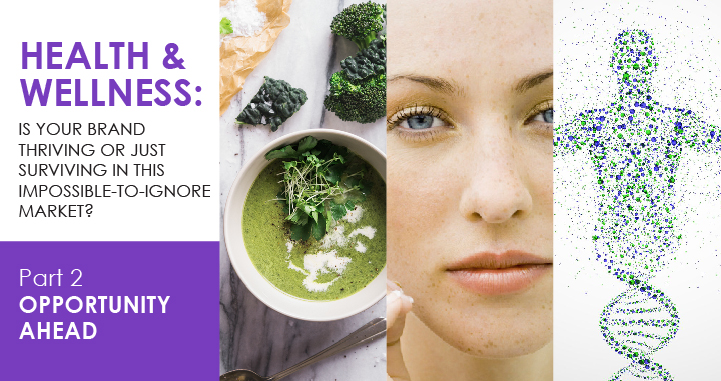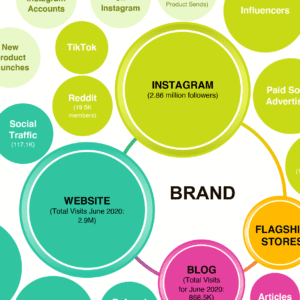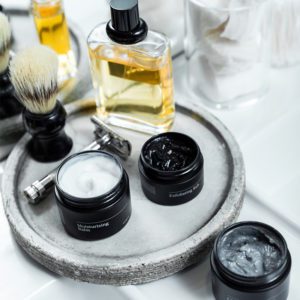Each year we speak to hundreds of leading experts and consumers about health and wellness. As we politely peer into consumers’ refrigerators, medicine cabinets and backpacks, we see a vast jumble of stuff. But after looking into enough cupboards, we also see patterns bubble to the surface – new behaviors, attitudes and needs coalescing to create a complex web of health-related trends and consumer insights.
While health-related trends are diverse and plentiful, they nonetheless cluster into several dominant themes. Here’s a look at just some of the themes and trends we’re seeing shape the world of health and wellness:
Theme 1: Self-Identity
People are viewing health as more than a state of being. They’re now taking a stand related to health. It’s a way to express who they are, the values they live by and how they structure their world. Several trends embody this theme:
Trend: Health as Achievement
In a hyper-competitive world where people are constantly measuring themselves against others, being healthy is becoming more than just genetic destiny or dumb luck. It’s becoming an achievement. The product of discipline, wise choices and willingness to take on challenge, healthy vitality is becoming a form of competition and therefore an expression of where one stands in the pecking order.
Trend: Ideological Food
While “food tribe” is fast becoming an over-used phrase, it describes a growing attitude to eating that’s not just motivated by weight or health, but values. Vegan, freegan, biohacker, locavore, urban homesteader, plant-based or simply sugar-free – the tribe itself doesn’t matter. What counts is that these tribalists are passionate believers who promote their stances on such issues as the environment, animal welfare, and the food system as well as nutrition.
Theme 2: New Laws Of Nature
Exciting new scientific discoveries – and budding theories – are providing greater knowledge of how the body works. These new laws of nature give people an opportunity for exercising more control over their health. Examples of trends demonstrating this theme include:
Trend: Personalized Health
Fueled by the mapping of the human genome, there is growing recognition that both health and disease are highly individualized. People respond differently to everything from diets to cancer therapy based on their cellular and microbial makeup – which means that each person is a group of one and health solutions ideally need to be personalized.
Trend: The Colony Within
Knowledge is growing about the human microbiome, a “system” of microbes that live inside and on the body – and that influence our physical and emotional health. Joy Yang of the National Genome Research Institute wrote, “We have learned that the bacteria living in and on us are not invaders, but beneficial colonizers. The hope is that, as research progresses, we will learn how to care for our microscopic colonizers so that they, in turn, can care for our health.” As evidenced by the growth in probiotics, consumers are starting to actively enlist the help of those good bacteria within.
Trend: Something Is In The Air (Water and Soil)
Over time, there has been a significant uptick in such conditions as obesity, asthma, infertility, and ADHD. While the causes are anything but clear, scientists and consumers are increasingly questioning if environmental toxins are to blame — whether it’s lead in water, BPA and BPS in plastics or obesogens anywhere and everywhere. Concern for children’s health is especially driving consumers to intentionally steer clear of perceived hazards.
Theme 3: Managing Mindfully
Aiming to prevent health problems before they happen – and treat them without drugs if they do – people are looking to lifestyle factors such as food, exercise, sleep and stress management to mindfully care for their health. A number of trends exhibit this theme:
Trend: Lifestyle Prescription
Increasingly, consumers and healthcare professionals are viewing the definition of “medicine” much more broadly than just drugs. Key lifestyle choices related to food and exercise become the medicines that can “treat” conditions like inflammation, for example, suspected as an underlying cause for everything from acne to Alzheimer’s Disease. To further the concept of exercise as medicine, the National Institutes of Health launched a major multi-year study to “uncover how physical activity changes the chemical molecules within our bodies, which could lead to people engaging in more targeted and optimized types of activity.”
Trend: Body, Heal Thyself
Instead of intervening in and disrupting the body’s natural processes to maintain health or cure disease, the latest thinking among medical professionals is that it’s better to help the body heal itself with medicines and therapies that follow natural mechanisms. Denise Grady, science reporter from The New York Times, provides a clear example: “Harnessing the immune system to fight cancer, long a medical dream, is becoming a reality. Remarkable stories of tumors melting away and terminal illnesses going into remission that last years – backed by solid data – have led to an explosion of interest and billions of dollars of investments in the rapidly growing field of immunotherapy.”
Trend: Slower and Simpler
High-intensity lifestyles centered on doing more, having more and being more are creating a backlash. With the goal of keeping life simpler and slower, people are turning to such slow-down behaviors as mono-tasking, nesting and swearing off alcohol. Slate associate editor L.V. Anderson wrote: “A series of experiments at Stanford showed that people who regularly multitask are a lot worse at basic tests of spatial perception, memory, and selective attention than people who don’t.” Less is more. Less is healthier.
Theme 4: Seamless Living
Increasingly, health and wellness is not a discrete aspect of life, but seamlessly integrated into busy schedules, physical spaces, and technology platforms. Several trends exemplify this theme:
Trend: Wellness Assimilated
People are most successful making positive health choices when those choices are affordable, convenient, positively motivating and consistent with their lifestyle and values. In other words, health and wellness activities need to adapt to people – and not the other way around. One example: Personal Trainer Pete McCall predicted, “faith-based exercise will become mainstream as churches, mosques, synagogues, ashrams, temples and other faith-based communities develop programs to promote fitness, health and wellness.” Places of worship are doubling as places of wellness.
Trend: Health Consumerism
The traditional doctor-as-authority healthcare model is breaking down. Patients, especially Millennials, are becoming consumers who “shop” for health-related information and care much the way they shop for anything else – as a commodity they can find online or at the most convenient outlet, be it a walk-in clinic or CVS.
Many of these trends suggest exciting new health and wellness possibilities for consumers. Notably, however, trends do not march together in lock-step. They often contradict one another – and that creates consumer conflict and tension even as it’s creating possibility.
In Part 2 of our series, we’ll examine how those consumer tensions open up opportunities for health and wellness brands that can help resolve them.

Part 2: TRENDING NOW
Trends are like habits. Even though embracing them can make a positive difference, it’s not always easy to do.
What makes embracing trends a challenge for consumers is that they’re a messy business. One health trend often conflicts with another – or competes with the practicalities and realities of everyday life. As a result, people often don’t act on health trends even if it would be good for them – or even if they truly want to.
What follows are several real-world tensions arising from these trends and themes that we’ve heard about in our many discussions with consumers – along with examples of brands that creatively resolve those conflicts, unlocking motivating new benefits and affirming consumer experiences.
Conflict 1: Health As Achievement vs. Lifestyle Prescription
Striving to reach peak health and performance can be at odds with a desire to manage health through more natural lifestyle choices.
Classic energy drinks reflect this conflict. They might help maximize achievement, but have too much sugar and artificial additives to fit with the Lifestyle Prescription trend. A brand like Eboost energy drink strives to resolve this compromise. Claiming that “we set out to find a cleaner way to fuel our busy lives”, the brand is non-GMO, gluten and soy-free, and low in sugar with no artificial flavors, colors or sweeteners. V8 +Energy is another example of a conflict-resolving energy drink, providing natural energy from green tea leaves with a serving of fruits and vegetables.
Looking at lozenges, Wedderspoon’s organic drops are made with Manuka honey, a variety of honey from New Zealand reputed to have a rich nutritional profile making it a “multi-faceted superfood”. The implied promise is a highly effective throat-soother that’s natural, with a robust list of “free froms”, and no sulfites, artificial coloring, flavoring, preservatives, or trans fats.
Conflict 2: Health As Achievement vs. Slower And Simpler
Consumers can find it hard to juggle powering up with powering down under the best of circumstances – in your own home, on a regular schedule, with proven routines – but it becomes infinitely harder when the routines and rituals are broken.
EVEN Hotels aims to help consumers have it all when they’re on the road, from spa-like relaxation to an array of fitness options — enabling guests to “keep active, rest easy, eat well, and accomplish more” during their stay. With a well equipped gym, in-room exercise equipment, and fitness class videos, EVEN helps guests keep challenging themselves physically while spa-inspired bathrooms, clean color palettes, and uncluttered spaces create a restful environment where “guests can unpack their best selves.”
Conflict 3: Health As Achievement vs. Wellness Assimilated
For those who see health as status, they never want to be laid low by health issues big or small. When health issues do arise, they want effective relief, plus the convenience of speed – two benefits that often do not go hand-in-hand with medication.
Dual Action Pepcid Complete aims to eliminate the classic trade-off in heartburn relief between speed and effectiveness. It’s a chewable antacid that “neutralizes acid in seconds” plus “helps control acid all day or all night” – delivering effective relief that assimilates easily into your day, requiring no extra thinking, waiting or planning ahead.
Conflict 4: Personalized Health vs. Wellness Assimilated
Individually-tailored health solutions offer the promise of more control and better results, but with a significant cost in convenience and practicality. Few have the time (or know-how) to analyze their DNA, let alone figure out which foods and/or exercises work best with their genotype.
While the science is still in its infancy, several meal solution brands are attempting to bridge that convenience gap, matching foods with genetics to help consumers take advantage of personalized health. Fitness Genes in the UK analyzes your DNA, identifies the genetic variations linked to physical performance and nutrition, and then recommends a workout and nutrition plan that will help you achieve your goals.
Conflict 5: Something Is In The Air (Water And Soil) vs. Wellness Assimilated
Controlling one’s environment by using products featuring the important “free froms” takes research, time and effort. Consumers believe it can also require using products with sub-par performance — which is not always a trade-off they’re willing to make.
Billing itself as “the first and only self-sealing, air-tight, non-plastic bag in the world”, Stasher re-usable storage bags claim to be safe for people and the planet. Made from 100% pure platinum silicone, Stasher says they’re free of BPA and BPS and safe for the freezer, stovetop, microwave, and dishwasher. The brand aims to help consumers care for the safety of their family and the environment while still meeting the practical needs of a busy household.
Conflict 6: Health Consumerism vs. The Colony Within
The desire to self-treat and self-prescribe appears to be growing, but it can be difficult to manage one’s microbiome. Even seasoned physicians are unclear how to keep the good and bad bacteria in balance – or even what that balance should be.
Drugstore probiotic brands like Align and Culturelle aim to make the dizzying world of probiotics simple and accessible. Each with just one strain of probiotics, they’re both clinically studied products readily accessible to consumers, unlike some more medically positioned probiotics which indicate they must be taken with professional supervision.
From cereal to snacks, companies are beginning to integrate probiotics into foods. Farmhouse Culture, which uses fermentation to offer probiotic-rich beverages, shots, vegetables and kraut krisps, in addition to straightforward sauerkraut, is “committed to transforming simple, organic ingredients into naturally probiotic superfoods and unforgettable snacking experiences” — making it easy and tasty to do a little something more for one’s microbiome.
Conflict 7: Wellness Assimilated vs. Lifestyle Prescription
The desire to proactively manage health through wise lifestyle choices is often foiled by everyday realities and by the need to keep things simple and seamless. Nowhere is that more true than with healthy eating.
Noom provides an example of a brand working to make adopting a healthy lifestyle not only accessible, but achievable and lasting. Based on the principles of Cognitive Behavior Therapy, Noom helps people “discover how their eating and weight management habits are impacted by self-confidence, stress, lifestyle, and the rollercoaster of motivation” and how they can “gain a holistic approach to health that goes beyond the scale.”
As another example, Slow Cooker Spice Blends From The Zen of Slow Cooking is intent on making it easy and efficient to prepare a healthy and delicious home-cooked meal. They provide the recipe, shopping list and tantalizing blend of spices – you provide the ingredients, slow cooker, and conviviality at the table.
The world of health and wellness promises to continue evolving apace, offering people a vision of possibility and hope for leading healthier and happier lives, but change doesn’t always go smoothly. When trends conflict with one another – or with the demands of everyday life – consumers can feel stymied, unable to move forward.
Here’s where proactive marketers and innovators can step in and offer solutions. By resolving the health and wellness conflicts consumers face with innovative products and experiences, insightful brand strategy can help people break through the inertia – propelling them forward along a health and wellness journey that propels the brand forward, too.





























